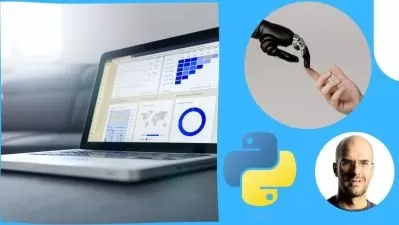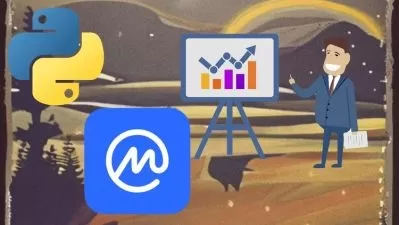Python Algorithms Masterclass
7:04:35
Description
Algorithms with Python for efficient coding and problem-solving skills
What You'll Learn?
- You can choose the right algorithm for various problem situations and solve them efficiently.
- You can solve problems systematically by learning algorithm design techniques such as divide-and-conquer, dynamic programming, and more.
- You can analyze the time and space complexity of your algorithms to improve their performance.
- You can implement various algorithms and data structures using Python, and apply them to real-world problems.
- You can understand the basic concepts of key data structures, such as stacks, queues, trees, and hash tables, and apply them to solve problems.
- You can learn efficient search and sort algorithms, including binary search, bubble sort, selective sort, quick sort, and merge sort.
- You can solve graph-based problems by learning Depth-First Search (DFS), Breadth-First Search (BFS), Minimum Height Tree, Shortest Path Algorithm, and more.
- You can solve mathematical algorithmic problems such as prime number checking, divisor calculation, prime factorization, greatest common factor, least common m
- You can use dynamic programming techniques to solve optimization problems and write code efficiently.
- You can solve algorithmic problems of different difficulty levels, gaining hands-on problem-solving experience.
Who is this for?
What You Need to Know?
More details
Description"Python Algorithms Masterclass" is a fundamental course for any developer who wants to solve complex problems effectively.
In this course, you will systematically learn various algorithmic problems and how to implement them efficiently using Python so that you can apply them immediately in your work.
Develop your ability to combine mathematical and computational thinking to design better performing algorithms, and even master how to analyze performance to choose the optimal solution!
The "Python Algorithms Masterclass" course is the best choice for anyone who wants to learn how to solve problems quickly and accurately in the real world.
In the “Python Algorithms Masterclass†course,
(POINT 1) You will learn a variety of topics from basic concepts of problem-solving to advanced algorithms.
(POINT 2) You will learn theory and practice simultaneously through various practical problems, and gain experience in implementing them yourself using Python.
(POINT 3) You will learn how to understand and analyze the time complexity and space complexity of algorithms to improve their performance.
(POINT 4) You will challenge yourself with difficult problems by gradually increasing the difficulty level from basic to advanced.
Introduction to Problem-Solving: Learn the basic concept of problem-solving, how to input and output data, and write problem-solving strategies in code.
Recursion: Learn the basic concept of recursion and efficiently solve problems such as Euclidean algorithm to find the greatest common divisor, Collatz conjecture, Tower of Hanoi, permutations, Fibonacci sequence, and more.
Sort: Learn the basic concept of sorting algorithms and efficiently solve problems such as word sorting, coordinate sorting, median elimination, determining anagrams, bubble sorting, insertion sorting, and more.
Sequential Search: Learn the basic concept of sequential search and efficiently solve problems such as locating elements, Palindrome numbers, Eratosthenes' sieve, building triangles, and more.
Binary Search: Learn the basic concept of binary seacrch and efficiently solve problems such as locating elements, playing twenty questions game, the batonic sequence, cutting trees, and more.
Stack: Learn the basic concept of a stack and efficiently solve problems such as visible sticks, postfix operations and transformations, stacked sequences, and more.
Queue and Heap: Learn the concept of a queue and a deque and efficiently solve problems such as changing median, Josephus, and more.
Hash Tables: Learn the basic concepts of a hash table and efficiently solve problems such as sums of two elements, Roman numeral conversion, and more.
Divide-and-Conquer 1: Learn the basic concept of divide and conquer and efficiently solve problems involving power of integer and matrice, quadtree, and more.
Divide-and-Conquer 2: Efficiently solve problems such as dividing and sorting a given list by a pivot.
Dynamic Programming 1: Learn the basic concept of dynamic programming and efficiently solve problems such as Fibonacci numbers, 2 x N Tiling, stair climbing, making it 1, finding the optimal value and the optimal solution simultaneously, and more.
Dynamic Programming 2: Efficiently solve problems such as how to compute binomial coefficients, paths on triangles, sequence of final common parts, and more.
Greedy approach: Learn the basic concept of the greedy approach and efficiently solve problems such as coin exchange, room assignment, and more.
DFS and BFS: Learn the basic concept of Depth-First Search and Breadth-First Search and efficiently solve problems such as a number of islands, maze navigation, and more.
Backtracking: Learn the basic concept of backtracking and use backtracking to efficiently solve problems such as N-Queens, and more.
Tree: Learn the basic concept of trees and binary trees and efficiently solve problems such as traversal of binary trees, reconstruction of binary trees, and more.
Graph: Learn the basic concept of graphs and efficiently solve problems such as Union-Find and finding the minimum height tree using the Kruskal algorithm, and more.
Shortest Paths: Learn the Daixtra and Floyd algorithms and efficiently solve problems such as finding the cost of the shortest path and finding the shortest path of all pairs.
Knapsack Problem: Efficiently solve problems such as the divisible knapsack problem using Griddy strategies and dynamic programming.
Computational Complexity: Learn computational complexity through the selection problem, and understand the basic concept of NP-Theory, NP-Complete, and NP-Hard problems.
Who this course is for:
- A learner who wants to learn Python syntax, algorithms, and data structures in a structured way.
- A computer science and software major who wants to gain diverse problem-solving experience.
- A beginner who has a basic knowledge of algorithms and data structures or who is interested in learning them.
- A developer who wants to develop efficient problem-solving skills in their projects and solve complex algorithmic problems in Python.
- A learner who wants to learn strategies and efficient coding methods for solving algorithmic problems in IT companies, programming competitions, and more.
- A learner who wants to develop computational thinking and problem-solving skills.
"Python Algorithms Masterclass" is a fundamental course for any developer who wants to solve complex problems effectively.
In this course, you will systematically learn various algorithmic problems and how to implement them efficiently using Python so that you can apply them immediately in your work.
Develop your ability to combine mathematical and computational thinking to design better performing algorithms, and even master how to analyze performance to choose the optimal solution!
The "Python Algorithms Masterclass" course is the best choice for anyone who wants to learn how to solve problems quickly and accurately in the real world.
In the “Python Algorithms Masterclass†course,
(POINT 1) You will learn a variety of topics from basic concepts of problem-solving to advanced algorithms.
(POINT 2) You will learn theory and practice simultaneously through various practical problems, and gain experience in implementing them yourself using Python.
(POINT 3) You will learn how to understand and analyze the time complexity and space complexity of algorithms to improve their performance.
(POINT 4) You will challenge yourself with difficult problems by gradually increasing the difficulty level from basic to advanced.
Introduction to Problem-Solving: Learn the basic concept of problem-solving, how to input and output data, and write problem-solving strategies in code.
Recursion: Learn the basic concept of recursion and efficiently solve problems such as Euclidean algorithm to find the greatest common divisor, Collatz conjecture, Tower of Hanoi, permutations, Fibonacci sequence, and more.
Sort: Learn the basic concept of sorting algorithms and efficiently solve problems such as word sorting, coordinate sorting, median elimination, determining anagrams, bubble sorting, insertion sorting, and more.
Sequential Search: Learn the basic concept of sequential search and efficiently solve problems such as locating elements, Palindrome numbers, Eratosthenes' sieve, building triangles, and more.
Binary Search: Learn the basic concept of binary seacrch and efficiently solve problems such as locating elements, playing twenty questions game, the batonic sequence, cutting trees, and more.
Stack: Learn the basic concept of a stack and efficiently solve problems such as visible sticks, postfix operations and transformations, stacked sequences, and more.
Queue and Heap: Learn the concept of a queue and a deque and efficiently solve problems such as changing median, Josephus, and more.
Hash Tables: Learn the basic concepts of a hash table and efficiently solve problems such as sums of two elements, Roman numeral conversion, and more.
Divide-and-Conquer 1: Learn the basic concept of divide and conquer and efficiently solve problems involving power of integer and matrice, quadtree, and more.
Divide-and-Conquer 2: Efficiently solve problems such as dividing and sorting a given list by a pivot.
Dynamic Programming 1: Learn the basic concept of dynamic programming and efficiently solve problems such as Fibonacci numbers, 2 x N Tiling, stair climbing, making it 1, finding the optimal value and the optimal solution simultaneously, and more.
Dynamic Programming 2: Efficiently solve problems such as how to compute binomial coefficients, paths on triangles, sequence of final common parts, and more.
Greedy approach: Learn the basic concept of the greedy approach and efficiently solve problems such as coin exchange, room assignment, and more.
DFS and BFS: Learn the basic concept of Depth-First Search and Breadth-First Search and efficiently solve problems such as a number of islands, maze navigation, and more.
Backtracking: Learn the basic concept of backtracking and use backtracking to efficiently solve problems such as N-Queens, and more.
Tree: Learn the basic concept of trees and binary trees and efficiently solve problems such as traversal of binary trees, reconstruction of binary trees, and more.
Graph: Learn the basic concept of graphs and efficiently solve problems such as Union-Find and finding the minimum height tree using the Kruskal algorithm, and more.
Shortest Paths: Learn the Daixtra and Floyd algorithms and efficiently solve problems such as finding the cost of the shortest path and finding the shortest path of all pairs.
Knapsack Problem: Efficiently solve problems such as the divisible knapsack problem using Griddy strategies and dynamic programming.
Computational Complexity: Learn computational complexity through the selection problem, and understand the basic concept of NP-Theory, NP-Complete, and NP-Hard problems.
Who this course is for:
- A learner who wants to learn Python syntax, algorithms, and data structures in a structured way.
- A computer science and software major who wants to gain diverse problem-solving experience.
- A beginner who has a basic knowledge of algorithms and data structures or who is interested in learning them.
- A developer who wants to develop efficient problem-solving skills in their projects and solve complex algorithmic problems in Python.
- A learner who wants to learn strategies and efficient coding methods for solving algorithmic problems in IT companies, programming competitions, and more.
- A learner who wants to develop computational thinking and problem-solving skills.
User Reviews
Rating

Udemy
View courses Udemy- language english
- Training sessions 97
- duration 7:04:35
- Release Date 2025/01/13










